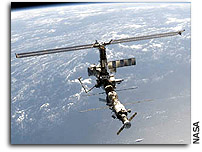ISS On-Orbit Status 14 July 2002
 All ISS systems continue to function nominally, except as noted previously.
All ISS systems continue to function nominally, except as noted previously.
Second weekend rest day for the crew.
The crew completed the regular daily routine tasks, i.e., SOSh life support
systems maintenance (CDR Korzun) and off-day Lab payload status check (FE-1
Whitson). Korzun also took SP urine collection and pretreat assembly
counter and SVO water supply counter readings for calldown to MCC-Moscow via
VHF, and performed the periodic BRPK-2 water condensate separator
inspection.
In its current troubleshooting of MSG (microgravity science glovebox) and
SAMS (space acceleration measurement system) difficulties, POC (Payload
Operations Center) requested crew assistance in verifying proper connection
of telemetry cables to the SAMS and the MLC (MSG laptop computer), in order
to obtain T/M data from the two units on the correct station LAN (local area
network).
Later in the day, the crewmembers were scheduled for a public TV downlink to
Moscow with greetings to flying enthusiast Aleksandr Begak. He is currently
setting up for a highly publicized flight from St. Petersburg to Moscow in
his paraglider “Scarab”, at an altitude of about 400 m, on Russian
television. [The downlink included a scripted “serpentine” chat with the
pilot, whose responses are to be recorded separately and inserted into the
pauses left by the crew. “We believe that the St. Petersburg-Moscow flight
will not only bridge these two cities on the planet, but also thousands of
hearts that love flight and the open sky. May the winds be at your back,
Sasha Begak!”]
The next major educational/PAO event for the crew is an interactive
audio/video Q&A for the International Toys in Space Project at the Houston
Museum of Natural Science and the American Museum of Natural History in New
York City on 7/16 (Tuesday). During the live event, Peggy Whitson will
demonstrate a number of common toys in zero-G (boomerang, jump rope,
AstroJax, Kendama, marbles, yo-yo), currently stored in the Lab, and respond
to questions by the attending middle school students.
Dual-angle testing of BGA (beta gimbal assembly) 2B is continuing via
S-band. The current LVLH (local vertical/local horizontal) earth-oriented
flight attitude will be maintained until tomorrow. Attitude will then
transition again to sun-oriented XPOP (x-axis perpendicular to orbit plane).
After some down-time of the Vozdukh carbon dioxide scrubber on Friday
morning, the machine is back in operation. CO2 levels, which had risen to
close to 5 mmHg, are back within acceptable limits. To make sure, the crew
was requested to call down this morning’s CO2 readings from the CDMK (carbon
dioxide monitoring kit) as well as a VAJ (vacuum access jumper) pressure
reading. Repair work on the CDRA (carbon dioxide removal system) in the
Lab, an eight-hour job for two crewmembers, will begin tomorrow (7/15) and
continue to 7/16.
The regular weekly data dump of all C&C MDMs (command & control computers)
and all powered PL MDMs (payload computers) is planned for tonight, via
S-band. This will include items such as HRDL (high-rate data link) S-RAM,
CCS bad sector data and the non-ground command log. Later, selected BDTs
(binary data tables) will be dumped to the ground. No crew involvement is
required.
CDR Valery Korzun’s task-listed Uragan earth imaging sessions with the Kodak
760 electronic camera with f800-mm lens and the LIV television camera today
had the following targets: the Balkans along the Adriatic, west and south
coasts of Turkey (Asia Minor), Cyprus, largest cities in Israel, the Spanish
city of Palma on Mallorca Island, the Nigerian city of Abuja, ruins of
jungle villages left by an ancient Indian civilization, the Kuril Islands,
and the city of Yuzhno-Kurilsk.
Today’s optional targets of the U.S. CEO (crew earth observation) program
were E. Mediterranean Dust and Smog (stable weather conditions over the
eastern Med favored smog formation at the time of this pass. As ISS crossed
the coast of northern Greece, the crew was to look obliquely to the right of
track to document the thickness and extent of visible aerosol palls over the
water, continuing until the coast of Israel was reached), Canary Cloud
Vortices (a persistent weather pattern over the eastern Atlantic this summer
continues to drive large fields of low stratus clouds past the peaks of the
Madeira and Canary Islands. Of interest on this pass: looking obliquely to
the right of track to document the stream cloud vortices generated downwind
from these islands), Congo-Zimbabwe Biomass Burning (this was an excellent
pass across the length of Zimbabwe in almost clear weather. Of interest: to
begin a mapping pass of this country’s complex and poorly mapped patterns of
vegetation and land use, particularly noting burn scar patterns),
Industrialized Southeastern Africa (with a weak offshore flow into the
Indian Ocean, crew was to look to the right of track as they crossed the
Mozambique coast for palls smoke and industrial aerosols) and Eastern United
States (this pass was through the heart of the most likely region of smog
over the eastern U.S. at this time of the year. The crew was to try for
oblique or limb views either side of track).









